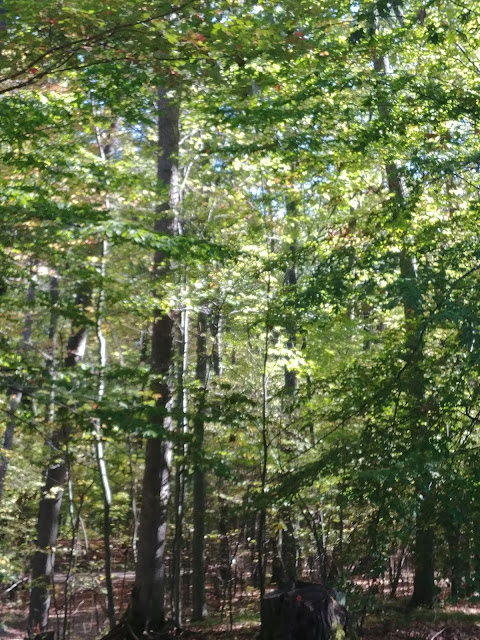Here are some of my construction tools!
Spray adhesive, masking tape, marking tools, exacto knife, gluestick, rotary cutter, magnifier, remotes, scissors, ruler, cutting mat
I've been wanting a large lightbox for years, and this project was just the excuse I needed to finally buy one, from Amazon.
In the photo below I have placed the area of the large full scale drawing I wanted to trace, the cabin (#9) on the right, over the lighted surface. Over it is a layer of muslin, which will be my foundation fabric. Having the design traced on the muslin will help me orient placement of my cabin fabrics as I collage them into place.
Muslin over pattern on lightbox, with photo nearby for reference as I trace.
The next step was to again trace the cabin design, but this time onto freezer paper. I use this to sometimes cut out actual templates, sometimes for tracing a specific shape onto tracing paper for then cutting out a shape, and sometimes to help me place an element exactly on the collage.
Cabin #9 design traced onto freezer paper.
The big pieces go on first. Everything has to be lined up as perfectly as I can get it.
Cabin #9, under construction.
After much trial and error, I learned that the best way to make those window frames was to cut them up from a single piece. Using the exacto knife made this possible. Because these frames are so delicate, the white fabric has been prepared with fusible web. This prevents the fabric from fraying and also assures the frames will stay put when I have positioned them exactly where they need to be.
Cutting out the inside of the window frame, through the tracing paper.
Another helpful discovery was to use the holes from the windows cut from my freezer paper tracing to help me "register" their placement onto their background fabric. (Alas, the lightbox could not shine through dark brown silk taffeta to help me see the tracing on the muslin.) This worked really well.
Placement of three windows using the freezer paper.
The picture below shows Cabin #3 well underway. (Sorry it is so blurry.) Some of the pieces are held in place with spray adhesive, others with fusible web, and others yet with gluestick. It just depends on the situation.
Cabin #3, the collage underway.
I was constantly referring to the printed photograph I am basing this composition upon, using that slick lighted magnifing glass to peer as closely as I could into the actual construction details, especially of the railings and the steps. I really want this to read properly. The eyes of my future viewers will catch anything false!
Magnifying the steps on Cabin #1.
I learned so much while making my first Cabin #1, that by the time #2 and #3 were done, my original Cabin #1 looked pretty rough in comparison, so I did it over. There will be trees added in the foreground in front of the cabins and behind them in the background, which will help seat them into place. Right now they look like they are floating. Of course there will be the foreground area with the picnic table too, but that will be created last. In landscape quilts I always work from back to front.
Cabins #1, #2, and #3, collaged on muslin foundations and taped into place on full sized pattern.
This was painstaking work, but I really enjoyed it.
The next step is to add the "leading", that is, the black outline, around all my shapes on these collages, because this commission is going to take the form of a stained glass quilt. But I am going to let these rest for a day before tackling that--it, too, will be a demanding and painstaking process.
Then I'll be able to start in on the background woods. That will be much more spontaneous!



































